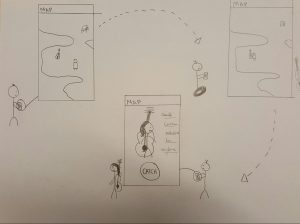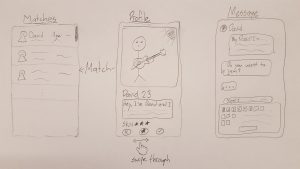a. Further updated task examples:
SUMMARY OF REVISIONS:
We have revised the task examples to be more fluid with each user. Adding more personality into the task examples pertaining to each individual task example user. With this revision, we hope to tackle the “list” format that was addressed during the MSII review.
TASK EXAMPLE 1:
Jeffrey is a 2nd year UBC student who loves to play music as a hobby, especially the guitar. He would like to play music for fun with new people and make new friends who also play music in the upcoming school year but is not actively looking. He didn’t make many new friends in his first year because he lacked time to join clubs and time to meet other new students. Mainly because he wants to meet other students on his own leisure and be notified when people around him are into music playing, like playing in a small band or having small jam sessions. He walks to UBC every weekday and knows that some of the students he passes and sees in his classes must play music. Jeffrey knows there are multiple ways of meeting new people in a community like UBC but like 1st-year, he lacks time to commit himself to clubs and smaller communities within UBC. So, he has tried talked to his friends from highschool indicating his willingness to play in jam sessions without much preparation beforehand. However, he has not received any interest from his friends because his friends, who live in different parts of the city, are either too busy or not willing to go out of their way to play at UBC. Though he has tried contacting his high school friends, being a UBC student he would rather prefer meeting other musically talented UBC students, people he would find trustful and similar to himself, in regards to personality and music skill level.
TASK EXAMPLE 2:
Alexander, a jazz bassist in his twenties who is more on the introverted side, is looking to find other jazz musicians to play with because he finds it a great way to improve his own skills. He has asked around in his friend circle and unfortunately the only friend he knows that is a musician plays the clarinet. It’s not that his friends don’t play music, it’s more so that they don’t particularly enjoy playing jazz music. In his longing to play with other jazz players, Alexander browsed classified sites such as Craigslist to connect with other like musicians but hasn’t been able to find posts about jazz players in particular. He has also thought about posting an ad on Craigslist, but he doesn’t feel comfortable posting information about himself for the whole world to see, especially since random strangers that he has no connections to will have access to his ad. Oddly enough, Alex has posted self-info about himself on Tinder but has only met up with people he had a handful of mutual friends with that helped establish a sense of personal connection. Although he is shy and doesn’t reach out to strangers in public very often, once he feels comfortable with someone he can be quite social.
TASK EXAMPLE 3:
Sharon is a 4th-year SFU student majoring in chemistry who is quite musically talented. She plays in small jam sessions casually with her roommates and has previously played in formal bands that performed in gigs and coffee shops. She has long since wanted to form another band but for the long-term, hoping to perform at local coffee shops and small gigs. Sharon can play a variety of instruments like electric guitar, electric bass, and drums, but she is most comfortable playing the piano as she has been playing piano for 10 years. Currently, she plans on playing with her 2 roommates who are excellent guitar players in various genres, and is specifically looking for a drummer for her new band but is open to other players that play different instruments from themselves. However, she’s not particularly comfortable meeting new people online because of all the scary stories she’s heard, so she is looking for someone who is from her school with previous band experience. Sharon had tried other alternative methods of recruiting new band members such as asking friends and friends of friends but has yet to have any luck finding a suitable drummer fitting to her particular tastes.
b. Low-fidelity prototype(s) demonstration:
Demonstration of the prototype can be seen https://www.youtube.com/watch?v=X8i_GbZPj40
c. Additional information about the prototype:
Our low fidelity paper prototype mainly supports the first and second task example (See task examples in section a). More specifically, Jeffrey, from task example 1, and Alexander, from task example 2, both want to find people to play with but were unsuccessful with the current platforms. They tried using Craigslist and joining social clubs to find other musicians. However, the use of Craigslist lack a sense of trust and real life situations tend to be more stressful.
Through our low-fidelity prototype, we intend to investigate if our proximity design is feasible and which of our profile layout better suits the purpose of our application. We suspect that users might have difficulties understanding the proximity aspect-passerby counter, map, and catalog without further explanation provided. We hope the result of our walkthrough will help us come up with an intuitive design to the problem. We have two profile interfaces to test if a transfer effect when viewing the profile page, or if a new way of representing the information is more suited. For our first profile interface, we focus on transfer effect by incorporating a similar architecture to facebook. It allows users to interpret information on profile page without unnecessary heading and titles. Our second profile interface focuses on prioritizing important information to our application. Based on our findings from our field study, we found a music sample to be an important element when determining user compatibility and as such, emphasized this in the second profile interface. Therefore, our second profile interface features a music sample at the top of the paper followed by user information with headings.
d. Walkthrough report:
After running through cognitive walkthroughs of our task examples 1 and 2, we found that the flow of our application was quite intuitive. Our participants were able to easily move through the pages of the app with relative ease and understanding. For example, our profile page and messaging system are components that are found in other popular social media apps and allow users to utilize transfer effects. The music samples on the user’s profile was a popular and useful widget, pointed out by multiple participants as a helpful way to determine if they would be a suitable jam buddy.
Conversely, we also learned the negatives of our application. Our opening screen in the app, a catalog of their current ‘matches’, confused participants and did not convey what the purpose of the page was. We also found that our profile page was missing the availability of the other user to explain when they were available to jam, and also the confusing use of a pop-up map with pins showing where the two users had passed each other. While the messaging system was easy to use, it was pointed out that it was missing a way to distinguish new messages from ones that had already been read, and lacked a way to initiate a new message with a user that had not been messaged yet. It was brought up that a splash screen could be used to explain many of these features and avoid the confusion that was apparent from the lack of an explanation.
Overall, we learned that participants found our prototype easy to use and found that our task examples were well supported by our interface. The participants were able to complete the task with no to minimal errors. However, they did encounter confusion when using our interface: First, both participants were confused about the term “catalog” which was a page for a list of people nearby. Second, was the map and the counters on the profile page. The counter was a button that takes the user to a map where it shows the location of which they passed each other. In the task example, Jeffrey was looking to form a band within a time period, participant reported that there should be details on the profile page about when they are available to jam to support this aspect of need. Participant two also suggests to have sample music on each list (messaging list, friends list, catalog), with the addition of having a list of sample music with titles for each file, if applicable.
e. Proposed goal(s) of experiment:
- Goal 1: Does the interface help the user establish or feel a sense of trust with the user by the information provided in the profile page, through the private message, and mutual friends.
- Goal 2: Are the users able to use the application to connect with suitable jam buddies for each other?
- Goal 3: Do users keep in touch with each other after using the application?
Although we have identified three goals that pertain to our interface, goals one and two will be pursued while goal three will not. Trust has become a key theme in this interface and because of this, we have identified goal one as the most important aspect to study as it relates to the ability of the interface to instill a level of trust in the user. Goal two is somewhat of an extension of goal one; finding a suitable jam buddy does include trusting the other user, but also includes personal attributes of the matched user such as the instrument they play and their preferred genre of music. Both of these goals are also testable with the same study. Goal three, while being important, will not be pursued as it requires user usage of the app to be tracked over a large period of time which is out of scope for this course.

 Photo taken by Edward Lee
Photo taken by Edward Lee Photo taken by Michael Williams
Photo taken by Michael Williams